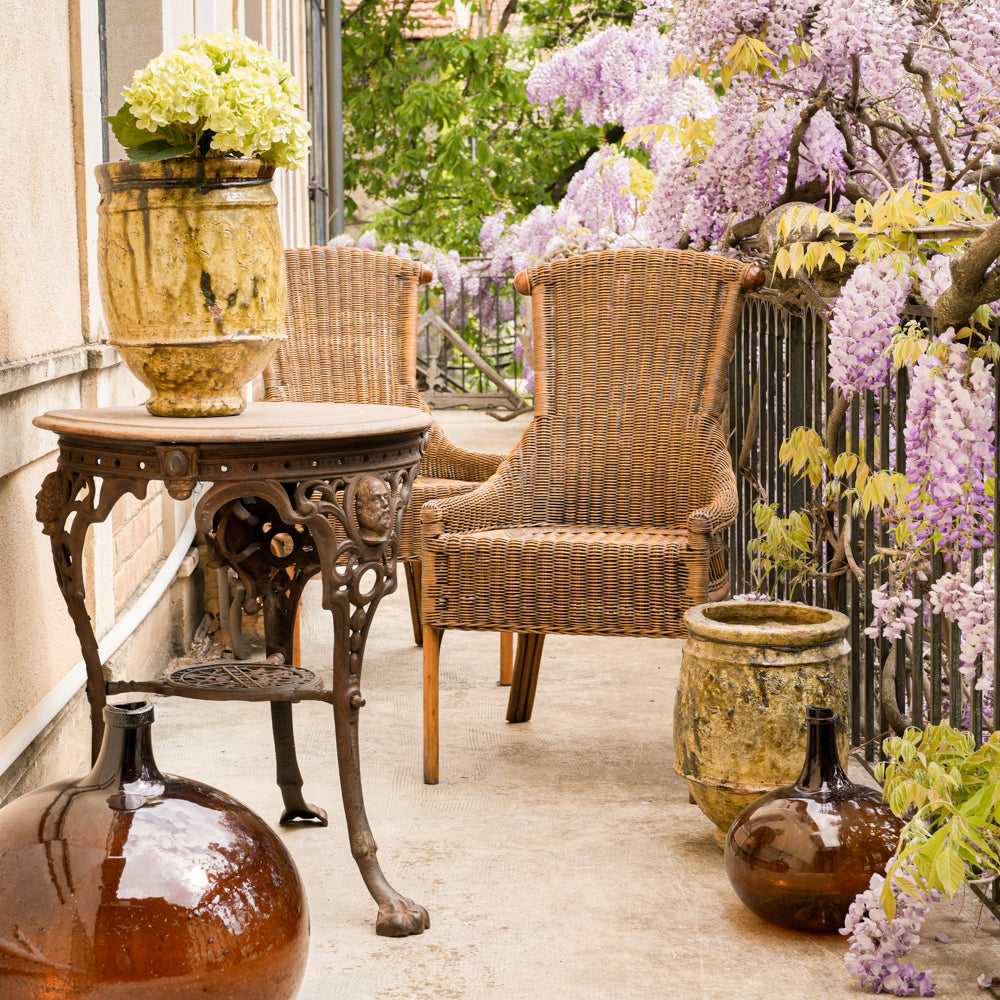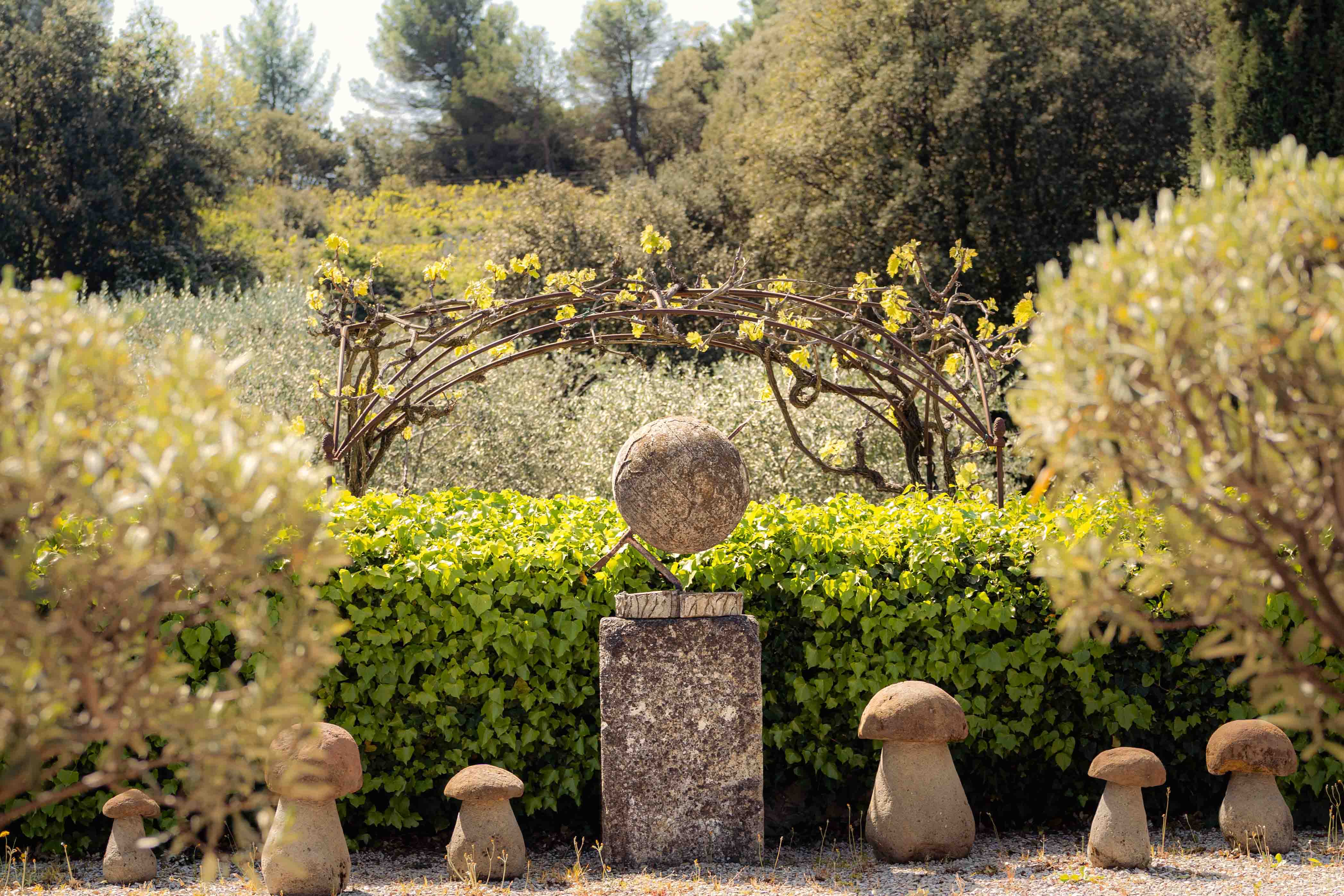Article: French Antique Furniture: Key Design Terms You Should Know

French Antique Furniture: Key Design Terms You Should Know
This glossary of French antique furniture design terms is a growing resource for collectors, designers, and enthusiasts. From trophies carved in the grandeur of Louis XIV to the elegant pieds cannelés of Louis XVI, it explains the names, styles, and decorative details that define French furniture. New entries are added regularly.
Trophées
(troh-fay)
In the decorative arts, a trophée refers to an ornamental motif featuring a grouped arrangement of symbolic objects—musical instruments, weapons, agricultural tools, or hunting gear—carved or molded in relief. The term comes from classical antiquity, evoking the Roman practice of displaying victory spoils, later transformed into a decorative emblem of triumph, art, or virtue in Renaissance and Baroque design.
By the 17th century, trophées became a favored decorative device in French interiors and furniture, flourishing under Louis XIV and especially Louis XVI, whose neoclassical style embraced their symmetry and classical references. You’ll find them in giltwood carvings on mirrors, consoles, wall appliqués, and boiserie, often centered in a frieze or crowning a pediment.
Louis XVI trophées are more refined and architectural than their Baroque predecessors, typically framed with laurel wreaths, oak leaves, and tied ribbons. Each motif carries meaning: musical instruments honor the arts, military trophies symbolize valor, while quivers and torches allude to love and enlightenment.
The examples here showcase this rich decorative vocabulary:
- A Louis XVI console table with a finely carved trophée musical under the apron, depicting a lyre, sheet music, and laurel branches.
- A Louis XVI giltwood wall sconce adorned with an elaborate trophée musical featuring a violin, trumpet, tambourine, and garlands tied with a ribbon.
- A Louis XVI giltwood mirror topped with a trophée du carquois et flambeau (troh-fay doo kar-kwah eh flohm-boh), symbolizing love (the quiver of Cupid’s arrows) and enlightenment or knowledge (the flaming torch).
A trophée isn’t merely decoration—it’s a visual narrative, embedding classical ideals into the design. Once you spot these motifs, you’ll see them again and again across fine French furniture, quietly speaking of artistry, meaning, and tradition.

Guilloché
(gee-oh-shay)
You’ll often hear guilloché mentioned in the world of watches and enameled boxes—but we see it most often on frames. Think beautifully detailed mirror or painting frames with quiet, rhythmic patterns—sometimes carved or incised into the surface, other times picked out in paint or gilding. The designs often follow a repeating wave or scale-like motif, catching the light and giving the surface a subtle sense of movement.
The technique itself is centuries old. It involves using a rose engine or similar machine to engrave ultra-precise, looping patterns—typically into metal, but also sometimes into wood. It first appeared in the 16th century and became more widely used from the 18th century onwards. It was popularized by artisans like Breguet in fine watchmaking, and famously layered beneath enamel by Fabergé.
On frames, guilloché adds a refined visual rhythm. It’s not showy, but it brings depth—a kind of quiet ornament that feels more architectural than decorative. Once you start spotting it, you can’t stop.

Col de Cygne (Swan Neck)
(kohl duh seen-yuh)
In French furniture and decorative arts, col de cygne refers to a graceful, elongated curve inspired by the neck of a swan. The term describes both abstract S-shaped curves and literal sculptural swan motifs, appearing across different materials and styles. From structural elements to decorative flourishes, the col de cygne brings movement, elegance, and classical symbolism to a piece.
While its roots trace back to classical antiquity, the motif gained popularity in French design during the late 18th and early 19th centuries. It became especially prominent in the Restauration period (1815–1830) and into Louis-Philippe (1830–1848), where neoclassical ideals merged with more romantic interpretations of natural forms.
The motif takes many forms:
- On a Restauration easel, carved swan heads cap the top of each support, their arched necks extending gracefully down the frame—blending sculpture and function in a distinctly early 19th-century design.
- In a cast iron garden table from the late 19th century, the legs curve outward in stylized swan-like forms, echoing the organic, flowing lines of the Belle Époque and Art Nouveau movements.
- On a pair of Napoleon III cast iron garden urns, the swans appear more literally, their necks and heads forming sculptural handles that frame the vessel—an ornamental flourish drawing from classical symbolism popular in the Second Empire’s neoclassical revival.
The col de cygne is versatile: in wood, it may terminate in a finely carved swan’s head; in iron, it becomes a stylized curve or bold figural form. Whether crowning an easel, supporting a marble top, or flanking an urn, it conveys grace and classical lineage, linking each object to centuries of mythological and decorative tradition.
Once you recognize it, you’ll find the swan’s neck elegantly curved across French furniture, a quietly powerful line that brings life and lyricism to form.

Bois Doré (Gilded Wood)
(bwah dor-ay)
Gilding is the art of applying a thin layer of gold—or sometimes silver—onto a surface such as wood, plaster, or metal to create a rich decorative finish. In French interiors, gilding has long enhanced mirrors, picture frames, architectural moldings, and furniture, particularly during the 17th and 18th centuries.
The traditional process began with preparing the surface using a ground made of gesso—a mixture of animal glue (usually rabbit-skin glue) and chalk. This mixture, applied in several thin layers, created a smooth, absorbent base for later stages. Once the gesso was dry and finely sanded, a clay undercoat called bole was brushed on, typically in red or yellow tones. The bole served both as an adhesive layer and as a warm undertone beneath the gold, subtly affecting the final color and depth. French gilders in the 18th century often preferred red bole for Louis XV and Louis XVI pieces to enhance the richness of the gold, while earlier styles sometimes used ochre or yellow bole for a brighter reflection.
Gold leaf, beaten into extremely thin sheets, was then carefully applied over the bole using a gilder’s tip—a soft brush designed to handle the delicate metal. Once in place, the gold could be lightly burnished with an agate stone to achieve a gentle sheen or left unburnished for a softer, matte finish. Gilding was not just decorative but carried significant status, especially in grand French interiors. At the Palace of Versailles, gilding was so integral to royal decor that entire teams of gilders were employed to maintain and restore the palace’s golden details—a tradition that continues to this day.
Silver leaf was applied using the same process as gold and was often chosen for interiors that favored a cooler, subtler metallic effect. Over time, silver leaf naturally tarnishes, developing a soft grey patina that many collectors find appealing. In some cases, silver leaf was coated with a yellow varnish to imitate gold more economically, especially on gilded glass—a technique known as verre églomisé.
Antique gilded surfaces are delicate and require gentle care. Dust should only be removed with a very soft, dry brush, such as a natural-bristle paintbrush. It’s important to avoid feather dusters, which can snag loose areas, and to never use water, cleaning sprays, or polish. Moisture and chemicals can lift or stain the gold leaf, and small chips or signs of wear are part of the authentic character of an antique piece and should only be repaired by a professional conservator.
In traditional French interiors, gilded elements bring warmth and elegance, offering contrast against pale painted walls or patterned wallpaper. A gilded Louis XVI mirror above a marble fireplace, or a gilt console table beneath a crystal chandelier, reflects the balance of refinement and comfort that defines French decorative arts. Gilded boiserie and moldings continue to be key features in restoring historic French homes, connecting today’s interiors with centuries of craftsmanship and style.




Leave a comment
This site is protected by hCaptcha and the hCaptcha Privacy Policy and Terms of Service apply.